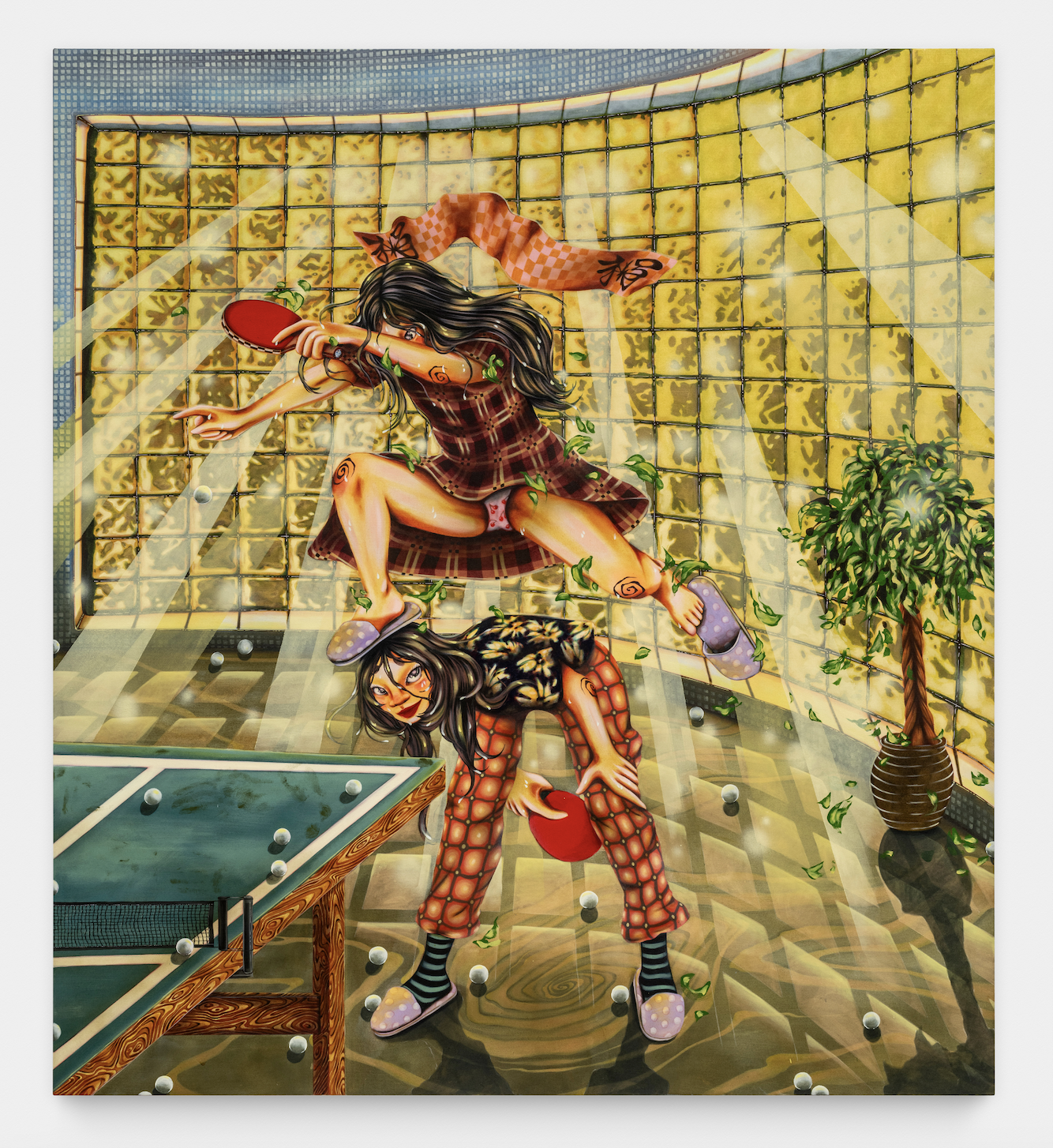Zoé Blue M.: Girls Just Want to Play and Bathe
From May 3rd to June 28th, Jeffrey Deitch’s 76 Grand Street location is home to LA-based artist Zoé Blue M.’s first solo show with the gallery. Through a suite of paintings and a sculptural installation, M. builds out her surrealist alternate universe: the takkyu onsen, or table tennis bathhouse, a woman-only haven of leisure and camaraderie. Her legion of identical, cartoonish characters unreservedly engage with their mirror images, creating an array of uncanny sequences that simultaneously speak to a non-corporeal equality of womankind as well as the existence of internal worlds and conflicts. The title Hard Boiled connotes the Japanese and Korean tradition of eating hard-boiled eggs at the onsen as a signal of steadfastness and evolution under strenuous circumstances.
The exhibition opens with its most stylistically unique and perplexing piece: a large, rectangular painting of four women behind a metal lattice. Each figure is portrayed wearing low-cut pajamas in a depthless wooden and tiled interior. Two women, loosely tied together with a polka-dot ribbon, gleefully cut their makeshift leash as two other figures smile at them. The intervention of the sharp lattice across the work is not just diverting but exclusive, explicitly barring the viewer’s entry into the women’s world. Given the pajamas and the tiles, it can be assumed the women are at a bathhouse. However, there is a complete lack of reference to bathing, reflecting M.’s larger narrative about the multifaceted, community-building roles that an onsen can play: the bathhouses literally tie people together. Along the same wall in the second room of the exhibition is a triptych that expands upon this sentiment. Through the windows of three green bathhouse doors, the viewer can glimpse four women lounging in a hot spring surrounded by cherry blossoms and bathed in glowing yellow beams of light. The center tiled frame is notably demarcated with the character for woman, calling attention to the gendered exclusion of M.’s universe. Again, the viewer is physically obstructed from the joy and leisure of the women, forced into the role of the voyeur. Again, none of the women seem to be bathing, only one in a state of undress. Instead, the painting focuses on the women’s private, lighthearted intimacy: one comically fells another with a large radish and two regard each other sweetly while playing with the water. Thus, bathhouses allow women to construct their own utopia, providing a rare moment of reprieve from male incursion.
Besides serving as the genesis for a feminine community, one can also read M.’s use of identical figures as the atemporal manifestation of an individual’s bathhouse experience, speaking to the more introspective element of leisure. Definitionally, the onsen is cleansing. A smaller work at the beginning of the exhibition directly provides this internal perspective. A topless woman floating in a solid, dark background is surrounded by viscous, amorphous, and luminescent water that both swirls around her chest and falls atop her head. The painting is devoid of any indications of the setting, entirely focused on capturing a sensation. The water purposefully curves around the central figure, defying gravity to gently immerse her in its embrace. In this scene, bathing is magical, comforting, and even transformative.
While M.’s bathhouses are serene, whimsical spaces of sisterhood and self-care, her table tennis paintings—the takkyu aspect—are packed with action. The piece at the far end of the second room depicts a woman soaring over her doubles partner to hit a high ball. At the apex of her jump, her scarf billows like a banner as perspiration coats her hair and limbs, light dramatically streaming in from the glass wall behind her as a makeshift spotlight. The partially concealed, focused expression of the leaping figure supercharges the scene with tension. The work on the opposite wall evokes the same drama. In what appears to be the aftermath of a brutal table tennis match, the losing player lies desolate on the ground, tears streaming from her unflinching eyes. The winner remains in a combative stance, paddle still ready to strike. A manual scoreboard in the bottom left corner reveals the devastating results: a total clean sweep.
Although saturated with competition and turmoil, the table tennis scenes are still intimate. The doubles players work together—while one jumps, the other ducks. It even appears as if the crouching partner is being used as a launchpad, her head perfectly aligned with the foot of her counterpart. Despite the clear strain of the move and the game, the woman on the ground is smiling and looking up at her partner with what appears to be pride. Similarly, even though the rainy, night-time match is explicitly a scene of conflict, M. highlights the closeness of the players and focuses on their shared emotional spirit rather than their competition. There is a notable lack of a table in the scene, ignoring the very nature of the sport to allow the characters to be physically brought together, their feet only inches apart. The collapsing of space illustrates takkyu as a bonding agent, whether it be between partners, opponents, or parts of oneself.
As a capstone to the exhibition, M.’s sculptural centerpiece transforms quotidian objects into otherworldly remnants of her table tennis bathhouse, testifying to the real-life possibility of realizing this communal woman-centered universe. The ping-pong table, adorned with lace, is multi-functional as a site for the sport as well as a storage for bathhouse materials. The green cupboards below are stocked with multiple pairs of lacy slippers, towels, hats, and robes decorated with recurring motifs, and plastic bath basins and egg cartons full of tennis balls. Through the private, unifying power of the bathhouse and the exhilaration of ping-pong, women can find relaxation, community, and self-discovery. The takkyu onsen is not just a surrealist fantasy—it is a lived experience.
Zoé Blue M.: Hard Boiled is on view at Jeffrey Deitch, 76 Grand Street from May 3 through June 28, 2025.






